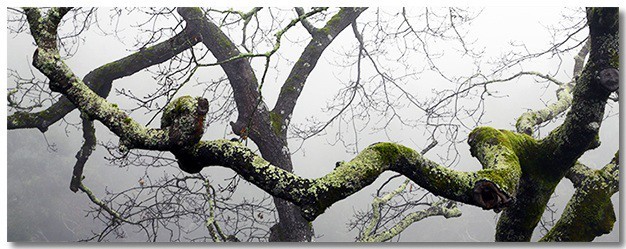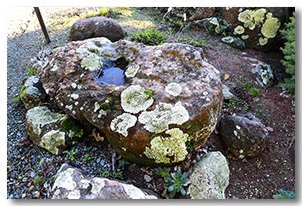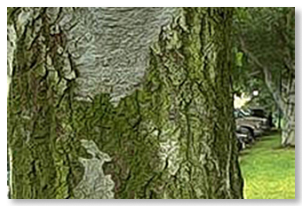Winter 2021-22
Lichens, Mosses, and Algae

By Laurinda Ochoa
Winter rains and cool weather wake up the lichens, mosses and algae growing in our gardens and yards. They are the areas of colored organisms we see growing on our trees, rocks, fences and roofs. Are they harmful and something we need to get rid of? Or are they a natural feature of our landscape that we can explore and enjoy?
Most lichens, mosses and algae are epiphytes, a type of green plant that survives on nutrients and water from the air. Many people are familiar with epiphytic orchids growing in the tropics. Our common garden epiphytes, like epiphytic orchids, use host trees and other structures for physical support and not for nutrition.
Generally, our garden lichens, mosses and algae don’t harm trees and plants and don’t need to be eradicated. Here is a short overview on Lichens, Mosses and Algae.

Lichens are symbiotic organisms composed of an alga and/or cyanobacteria with a fungus. Like mosses and algae, lichens have no roots or woody structures. They grow by attaching to a substrate and can be found on wood, stone, soil and even concrete. On trees, lichens attach to sun-exposed twigs and branches. They don’t harm trees because they don’t take nutrients from the bark and don’t cause disease. In Contra Costa County, lichens are commonly found on mature oak, maple and other landscape trees, as well as on fences and stones.

Mosses are small, non-vascular flowerless primitive plants that form dense green mounds or low mats in damp and shady areas of our gardens. Like mushrooms, they reproduce by releasing spores into the air. The leaves of mosses are generally only one cell thick and are able to quickly and efficiently absorb moisture from their environment.
Mosses, together with liverworts and hornworts, are members of the bryophyte family of plants. Bryophytes occur worldwide, including in Antarctica, and can grow on any surface since they don’t have roots. Locally we find them growing on rocks and trees near creeks, on bridges and older roofs and in the quieter areas of our gardens.

Algae are relatively simple, primitive organisms in the plant family and lack roots, stems, flowers, or leaves. Like lichens and mosses, algae do not take nutrients from the surfaces they grow on. Most people know algae as the green, wet and slippery growth on our garden walkways or sidewalks. Other types of algae can be red or brown and are found near waterways and on soil.
Although algae don’t feed on garden plants and don't harm surfaces they grow upon, they can slow down plant root growth in our gardens by making it harder for oxygen and gases to get into the soil and reach plant roots. Read on for more in-depth information on lichens, mosses and algae See UC Pest Note for important information on how to use these in the garden: Managing Pests in Gardens: Environmental Factors: Lichens, Mosses and Algae—UC IPM
